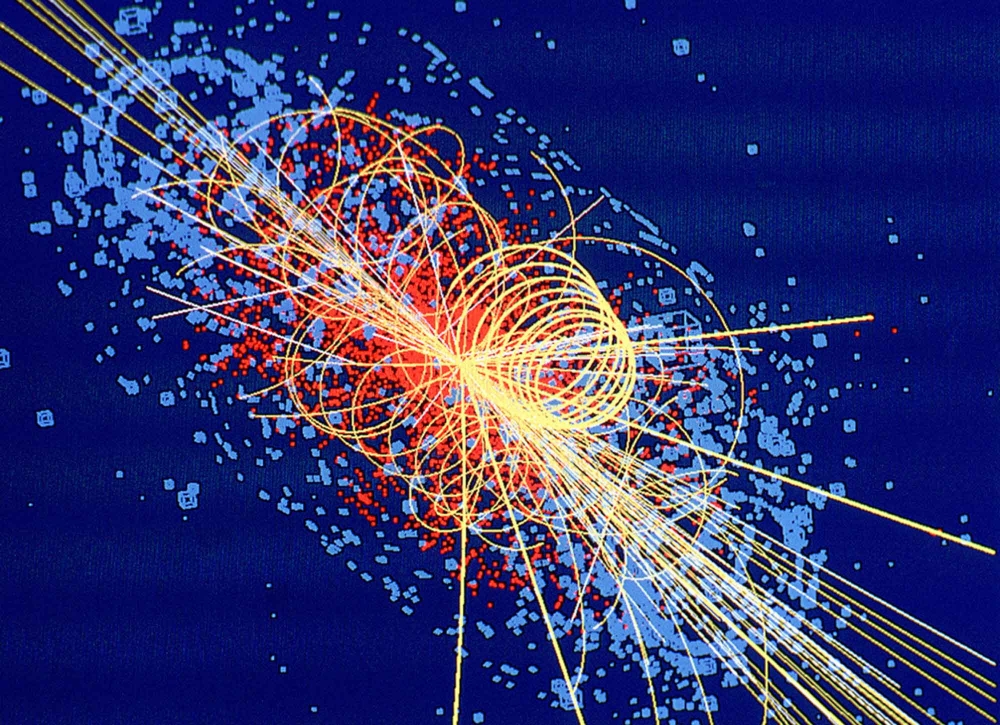
Nature's Powerful Simplicity
In a paper published in the journal Nature Physics today, the Compact Muon Solenoid (CMS) experiment at the European Organization for Nuclear Research (CERN) reports new results on an important property of the Higgs particle, the discovery of which was announced by the ATLAS (A Toroidal LHC Apparatus) and CMS experiments on July 4, 2012. The new CMS result follows preliminary results from both experiments, each of which both reported strong evidence for the Higgs boson’s decay into fermions late in 2013.
The discovery of the Higgs boson validated a half-century-old theory about how subatomic particles acquire mass. It is associated with a mechanism first put forward in 1964 by Robert Brout, François Englert and Peter Higgs to account for the different ranges of two fundamental forces of nature.
“The main reason for the Higgs boson idea initially was to explain how the very heavy (W and Z) bosons got heavy,” said Joseph Incandela, UC Santa Barbara professor of physics and spokesman for the CMS experiment at the time of the Higgs boson discovery. The Higgs boson is unique in that it presents zero angular momentum, or “spin,” while other bosons exhibit integer — whole number — values of spin, and fermions have half-integer values of spin. Later, explained Incandela, the idea was adapted for use to give mass to fermions. But, in order to test that idea fully, it was necessary to measure the direct decay of the Higgs boson into all kinds of particles.
The Higgs boson discovery was based on measurements of the decay of the Higgs to other bosons, the carriers of nature’s forces. The recent results reported by ATLAS and CMS discuss the decay of Higgs bosons directly to fermions, the particles that make up matter. Now referred to as BEH (Brout-Englert-Higgs), this mechanism is postulated to give rise to the masses of all the fundamental particles.
“When Fabiola Gianotti — the former spokeswoman for the ATLAS experiment — and I announced the discovery for our respective experiments, the evidence for a signal was only clear in the decays to bosons,” Incandela said. “It is harder to see the decays to fermions so this was not so surprising, but it was a major open question that was on my mind that day, and one that we knew we’d have the opportunity to address with more data.”
The measurements from both experiments have given substantial evidence that the Higgs boson decays directly to fermions at a rate consistent with that predicted by the Standard Model of particle physics, the theory that accounts for the fundamental particles of visible matter and the interactions that work between them, giving structure to matter.
“With our on-going analyses, we are really starting to understand the BEH mechanism in depth,” said current CMS spokesperson Tiziano Camporesi. “So far, it is behaving exactly as predicted by theory.”
It could have been that another particle would be required for the fermions, said Incandela, but the result not only confirms the Higgs’ link to both fermions and bosons, but also the powerful simplicity of nature. “This result verifies to us in a direct and clear way that nature has to a large extent chosen the most simple and efficient possible way to generate mass,” he said.
There’s more to come, according to Incandela, including further research to address theories such as supersymmetry and predictions that many types of Higgs bosons exist among which one type would behave like the Higgs boson currently being studied.
“These results show the power of the detectors in allowing us to do precision Higgs physics,” said ATLAS spokesperson Dave Charlton. “We’re coming close to achieving all we can on the Higgs analysis with Run 1 data, and are all looking forward to new data when the LHC restarts in 2015.”
The Large Hadron Collider, CERN’s flagship research facility, has been off-line for maintenance and upgrading in last 18 months. Preparations are currently underway for it to restart early in 2015.
More information will be available as results are announced at the International Conference on High Energy Physics (ICHEP), which begins at Valencia, Spain, on July 2.



